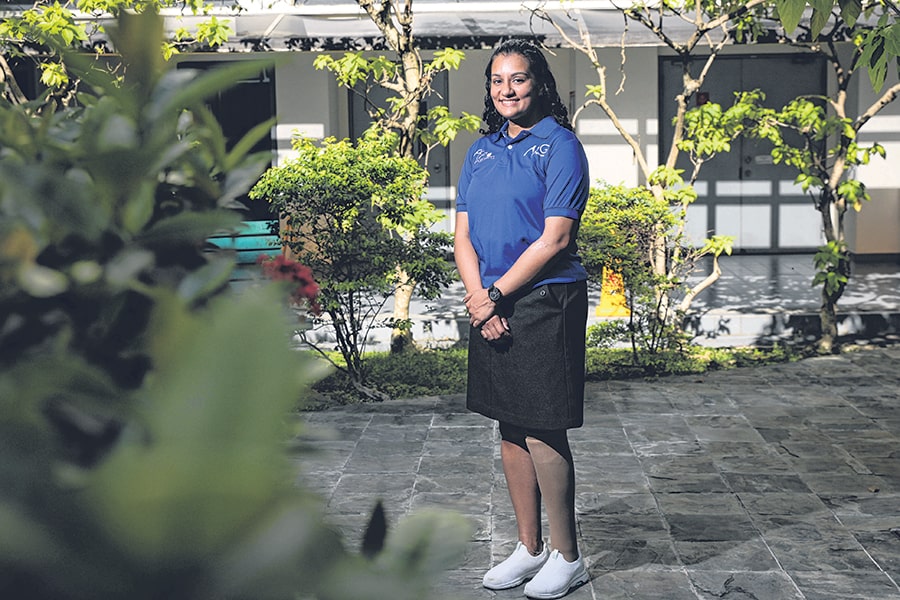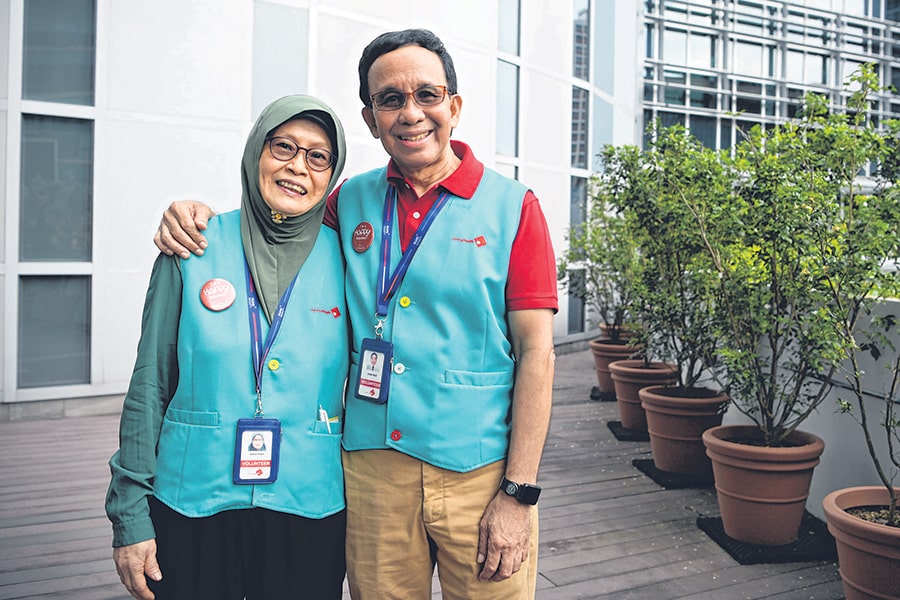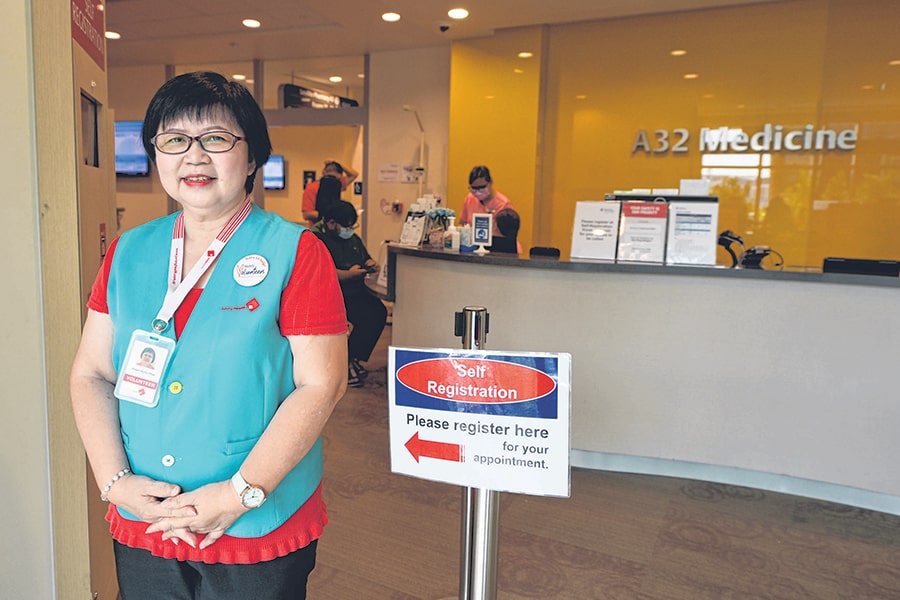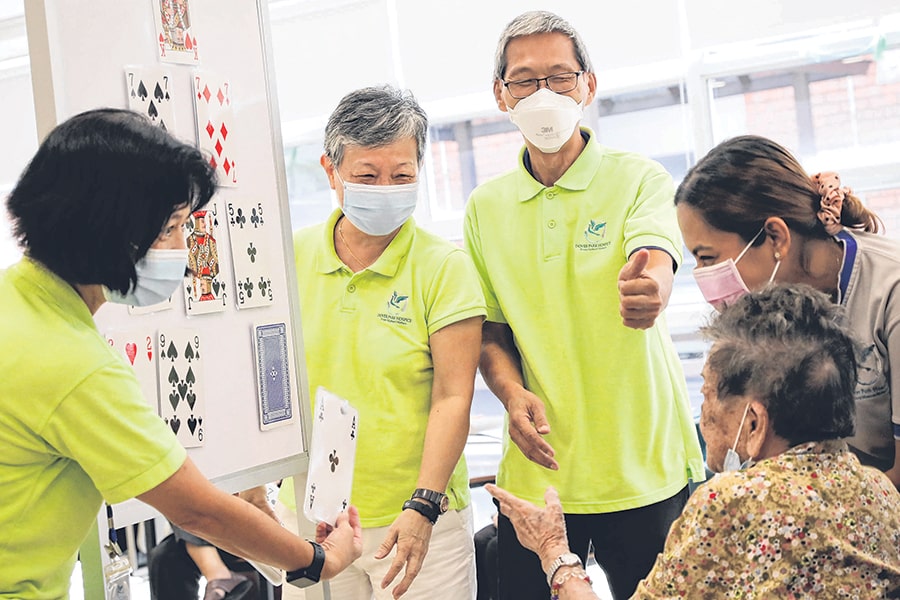 Tan Tock Seng Hospital volunteer Saritha Viswanadhan, who lost her leg at age eight, helps out in the amputee support group. ST PHOTO: ONG WEE JIN
Tan Tock Seng Hospital volunteer Saritha Viswanadhan, who lost her leg at age eight, helps out in the amputee support group. ST PHOTO: ONG WEE JIN
The Straits Times (27 July 2022)
From aiding patients in getting around hospitals to navigating the lived realities of illness, volunteers provide invaluable assistance
Ms Saritha Viswanadhan, 39, volunteers at Tan Tock Seng Hospital’s (TTSH) amputee support group, helping patients who are figuring out how to live life with a prosthetic limb or wheelchair.
Her left leg was amputated at the hip after a road accident when she was eight, and she knows how reassuring and affirming it is to hear from others in a similar position.
Like her, hundreds of people in Singapore donate their time to hospitals and care centres, perhaps providing peer support, engaging patients or helping them through various stages of their medical appointments.
Some, like Ms Saritha, have lived experience of the disease or medical condition. They can help with questions that doctors or therapists might be less well-placed to answer, such as how to deal with the rashes and blisters that come with wearing a prosthetic limb. Other volunteers offer help with registration at hospitals or guide patients to where they need to be.
Worry and illness can make it harder for patients and caregivers to manage such simple tasks, as volunteer Johari Nazir knows firsthand.
 Volunteers Johari Nazir and his wife Aisha Pwee greet and guide patients at Ng Teng Fong General Hospital. ST PHOTOS: NG SOR LUAN
Volunteers Johari Nazir and his wife Aisha Pwee greet and guide patients at Ng Teng Fong General Hospital. ST PHOTOS: NG SOR LUAN
The 71-year-old former sales and marketing manager has been a hospital volunteer since 2006. He first offered his time at Alexandra Hospital, then Khoo Teck Puat Hospital.
He now greets and guides patients at Ng Teng Fong General Hospital (NTFGH).
He recalls that many years ago, when he took his late mother to a hospital, he was worried about finding the clinic and also about leaving her alone in a wheelchair while he parked his car. A staff member calmed him down and took charge of his mother’s wheelchair.
"I was so impressed with the service and with the person who helped my mother," he said. Later, he decided to volunteer and help others in turn.
He volunteers at least once a week, as does his wife Aisha Pwee, 69, a former secretary.
There are about 60 volunteers across NTFGH and Jurong Community Hospital (JCH). They may greet and guide patients or volunteer at the pharmacy to pack prescribed medicines before pharmacists verify and dispense them.
Some volunteers support the work of nurses by serving patients meals or feeding them.
Volunteers go through training before being deployed.
From 2020 to the first part of this year, people were unable to volunteer at hospitals because of pandemic restrictions. This was disappointing for senior volunteers like Mr Johari and retired accountant Angie Ng, 61, who used to volunteer for up to 22 hours a week at NTFGH and JCH.
 Ms Angie Ng, who volunteers at Ng Teng Fong General Hospital, often helps Cantonese- or Mandarinspeaking patients communicate with doctors or their caregivers.
Ms Angie Ng, who volunteers at Ng Teng Fong General Hospital, often helps Cantonese- or Mandarinspeaking patients communicate with doctors or their caregivers.
"It was like my new job," says Ms Ng, who, like all volunteers, receives no payment for her services.
She greeted and guided patients, helped nurses watch over patients in the wards to prevent falls and contributed to patient engagement activities such as art and craft sessions or concerts.
"The hospital staff would tease me, saying: ‘You come earlier than me and leave later," she says. "Why do I do this? I’ve a passion to serve and the joy it brings others keeps me going."
Volunteers provide a personal touch
Now, she volunteers once a week, often helping Cantonese- or Mandarin- speaking patients communicate with doctors or their caregivers. “That’s the most enjoyable job,” she says.
She recalls translating for a mother and daughter pair who could not communicate well and were at odds over the mother’s desire to cook and serve rich food at family meals when she was supposed to be on a lighter diet.
Ms Ng explained to the daughter that the mother cooked rich food so she could tempt her children to visit and eat. The mother broke down crying in relief after Ms Ng’s explanation.
“I felt really happy that I could help them,” says Ms Ng, who is married and has a grown-up daughter.
Volunteers support the work of trained healthcare professionals and add a personal touch that patients find invaluable.
TTSH has 340 volunteers across 36 volunteer programmes and patient support groups, including the amputee support group where Ms Saritha has volunteered since moving here in 2016 with her consultant husband and their daughter from Mumbai.
“A support group is an incomparable strength,” she says. “While your caregivers, family and doctors have your best interests in mind, the support groups have many people who’ve experienced exactly what you have and can offer you the kind of solutions and support that others cannot.”
The patients she speaks with are often still grappling with the implications of the amputation.
“Some are still in shock and anxious about what life is going to be like after this. I tell them: ‘It is a lot to process. Be kind to yourself. It’s going to be okay, we’re all here to help.’”
She adds: “Disability is only part of a person. It doesn’t define the person. Every society should learn to normalise disability. It’s just a state of being.”
Apart from helping out at the amputee support group, the dependant’s pass holder and Indian national also volunteered to pack medicines at the outpatient pharmacy in TTSH from March to May this year, when the hospital asked for an extra pair of hands.
She says she is ready to help whenever the hospital asks, as she is grateful for the care and support her family received after her husband suffered a brain aneurysm in 2020. He received surgery at TTSH and recovered within months.
“I connected to support groups immediately after my husband’s health scare and they have helped us immensely,” she says.
“When doctors or therapists are brutally honest, we take longer to accept them. When similar things are mentioned by those in your support group, one connects to it more easily because they’ve lived through a similar situation. At times, they are able to cushion the blow and help you deal with eventualities gradually.
“Doctors and therapists don’t usually have that luxury. Support from both sides is necessary and can complement each other beautifully.”
 Retirees Sabrina Tan and Lee Chuan Too (both centre) volunteer at Dover Park Hospice. ST PHOTO: ONG WEE JIN
Retirees Sabrina Tan and Lee Chuan Too (both centre) volunteer at Dover Park Hospice. ST PHOTO: ONG WEE JIN
Learning from the dying
Volunteering with dying patients teaches valuable life lessons, say volunteers at Dover Park Hospice.
About 400 volunteers help with patients at the hospice in Jalan Tan Tock Seng. It is a non-profit organisation set up in 1992 to provide comfort and care for people with advanced disease.
The hospice cares for both resident and non-resident patients. Non-residents may use the daycare centre or receive care at home.
Hospice volunteers help take patients out for weekly excursions, organise events and craft activities and even maintain the green spaces at the hospice.
Volunteers also take patients on home care to medical appointments and cut their hair.
Ms Sabrina Tan, 67, a retired bank worker, has been volunteering at the hospice since 2015. One of her tasks is to staff a makeshift “coffee shop” that lets hospice patients experience the atmosphere of a kopitiam. She also befriends patients and helps with art therapy activities.
Ms Tan likes chatting with patients and seeing them enjoy activities. She recalls a patient in her 90s who gets as excited as a child when she wins a prize.
It can be challenging for some volunteers to deal with the eventual passing of the patients they have come to know.
Ms Tan’s advice is to “manage your emotions”.
“I have friends who told me: ‘I can’t do your kind of volunteering because I’ll become too depressed,’” she says.
“Death is part and parcel of life. If you feel emotional about it, you can’t do volunteering in this setting.”
She and other volunteers were unable to interact directly with patients in 2020 because of pandemic restrictions. Face-toface interaction resumed last year with safe management measures in place, and more volunteers returned this year.
Retired shop assistant Lee Chuan Too, 62, was happy to resume his volunteer sessions at the hospice. He has been volunteering there for the past five years. He helps take patients on weekly outings to national parks or other places of interest.
Excursions require up to three volunteers a patient – one to push a wheelchair, one to hold an umbrella for shade and one to help take photos or otherwise assist.
Patients enjoy the excursions and Mr Lee says interacting with the patients has taught him how to make the most of life.
“In the beginning, you think you are going there to help the patients. If you start volunteering, you realise that the one who really benefits is you,” he says.
“I come and learn from them how to age properly. They teach me a lot, like how to make the most of your time.”